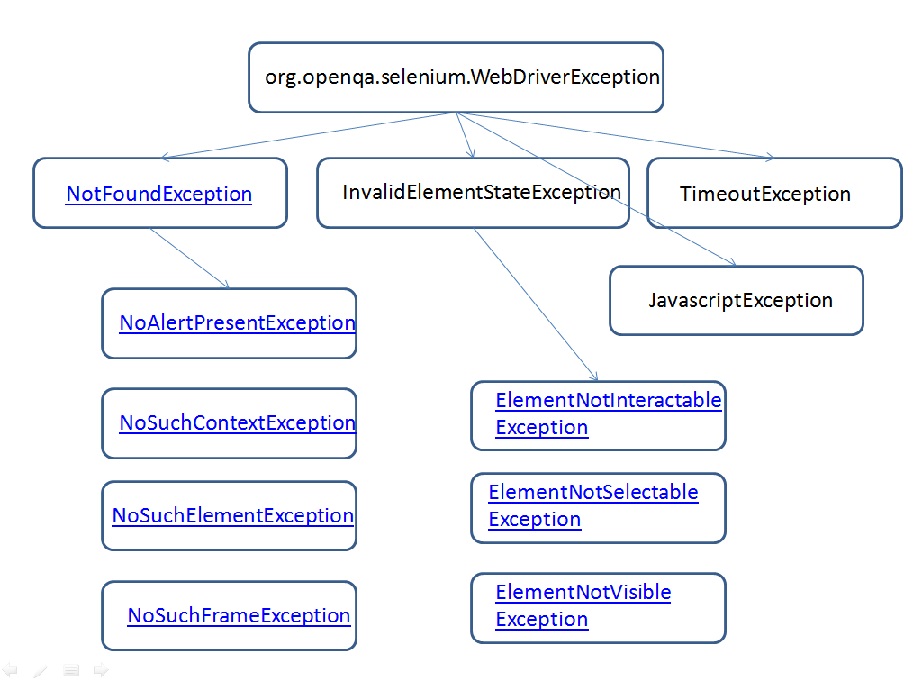
In an era of growing software development, testing plays a crucial role in making the process fault-free. Selenium is one such tool that aids in detecting errors and resolving them. It is a famous testing framework for automating web browsers and testing web apps. While Selenium proffers a great set of tools for web automation, it’s crucial to understand and maintain exceptions that can occur during automated testing.
Exception handling and bug reporting are key areas to consider while designing the automation framework. Though countless Selenium exceptions might occur in all the Selenium WebDriver code, some Selenium exceptions are precise to the programming languages supported by the framework e.g. Python, C#, Java, etc. Though automated tests seem stress-free, it has multiple challenges, such as managing a stable environment and designing and maintaining strong automation frameworks. handle common exceptions effectively.
What is an Exception?
Exception as the name suggests is an action that occurs during the execution time of a program. There might be multiple reasons behind the exception’s occurrence. Handling exceptions is a fundamental facet of writing reliable and robust software.
Exceptions are classified into two different kinds:
- Checked Exception:
- Such exceptions are exceptions that the compiler mainly focuses you to either declare (propagate) or catch (handle) when they occur in your code.
- These exceptions usually signify error circumstances that are expected or recoverable. For instance, when you work with file I/O, you have to handle exceptions such as IOException as files might not always be accessible or available.
- Unchecked Exception:
- These exceptions, also called runtime exceptions, are exceptions that can happen at runtime and aren’t required to be declared or caught by the compiler.
- Unchecked exceptions sometimes represent programming faults or unexpected situations that might not be simple to recover from. For instance, NullPointerException happens when anyone tries to access a null object, which is normally a coding error.
Significance of Exception handling and Error reporting in Selenium
- Exception handling in Selenium is crucial as web apps can be dynamic, and several unexpected events can happen during test implementation.
- Properly handling exceptions guarantees that your test scripts continue to execute smoothly even when unexpected behavior or errors occur. This prevents the complete test suite from failing because of a single issue.
- Selenium provides mechanisms such as the WebDriverException and try-catch blocks class for handling exceptions. Customized exception classes can also be generated to handle app-centric flaws gracefully.
- Handling exceptions allows you to capture and log relevant info, making it easy to diagnose and mitigate problems during test implementation.
Handling Exception in Selenium
1. Use Try-Catch Blocks:
- One of the fundamental methods to handle exceptions in Selenium is by making use of try-catch blocks. You can wrap the code that might pitch exceptions within a try block, and then catch those exceptions in a catch block.
- By using try-catch blocks, one can easily prevent the complete test from failing because of a single exception. Instead, the automated test script can recover properly or report the concern and continue execution.
Syntax for Try Catch:
try {
//Some code which may throw an exception
}
catch(Exception ex) {
//here we catch exceptions and do some logging or any other logic.
}
2. Particular Exception Handling:
- Distinct exceptions might necessitates distinct handling strategies. For instance, a NoSuchElementException might need a varied response than a TimeoutException.
- Determine the precise exceptions that your tests may encounter and execute appropriate handling for every type.
3. Page Object Model (POM):
- Make use of the pattern to capture web page interactions and components. This makes it simpler to manage exceptions linked to components on precise pages.
4. Test Data Management:
- Try to handle exceptions linked to test data. Make certain that your tests have access to the required test data and manage cases where information is invalid or missing.
5. Continuous Improvement:
- Frequently review and update your exception-handling strategies. As your app evolves, new exceptions might arise, and current ones might require distinct handling approaches.
Benefits and Drawbacks of the Avoid-Handle approach
The “Avoid-Handle” approach in software development and tests refers to an approach where you try to prevent or avoid exceptions and errors from happening in the first place.
| Advantages | Disadvantages |
| Improved Software Quality: By smartly detecting and addressing potential issues, you can considerably enhance the overall quality of your software. This results in some errors and a highly reliable product. | Complexity: Implementing problem prevention and handling mechanisms can introduce intricacy into the codebase. This complexity can be perplexing to handle and debug. |
| Enhanced User Experience: Avoiding errors or handling them with poise can give a smoother user experience. Consumers are less likely to encounter disruptive issues or crashes. | Development Time: Writing code to manage potential faults and exceptions can be arduous. This slows down development, particularly if you spend extra time on unlikely edge cases. |
| Cost-Effective: It’s often cost-effective to address problems early in the software development procedure or to design systems to manage bugs rather than to cope with them after they happen in production. | Overhead: Handling bugs often requires extra code and resources, which can result in performance overhead, particularly in resource-constrained environs. |
| Maintainability: Code that is perfectly designed with bug prevention and management in mind tends to be highly maintainable. It’s simpler to update and extend when you have mechanisms to deal with errors. | False Positives: Overly aggressive bug handling can sometimes result in false positive error reports. This can confuse software developers and make it tough to distinguish genuine problems from noise. |
Why Exception Handling is a crucial facet of Programming?
Here are some of the key reasons why exception handling is significant:
- Easy to Detect Flaws with Custom Messages & Stack Traces
- Determines the Root Cause of the Issue
- Handles Program Smoothness after Exception
- Simple Identification of Error Types
- Facilitates Meaningful Error Reporting
- Proper Degradation and Recovery
- Security & Data Integrity
- Improved Software Reliability
- Maintains User Confidence
Common Exceptions in Selenium
NoSuchElementException
- Description: Take place when Selenium can’t locate a component based on the provided locator strategy (e.g., findElements or findElement).
- Common Causes: Changing or incorrect element locators, asynchronous loads of elements.
- Handling: Check the stability and correctness of your locators. Use explicit waits to make certain that the element is present before communicating with it. Consider using more robust locators such as XPath or CSS selectors.
2. ElementNotVisibleException
- Description: Thrown when any component is in the DOM but not visible on the web page.
- Common Causes: Element outside the viewport, element hidden by CSS.
- Handling: Confirm the element isn’t hidden by CSS or obscured by other elements. You can use projected conditions for clickability or visibility before interacting with such components.
- StaleElementReferenceException:
- Description: This happens when any component that was previously located becomes stale or is no longer a portion of the DOM.
- Common Causes: Page navigation or refresh, DOM alterations.
- Handling: Reload or refresh the web page if required and locate the element again. Execute try-catch blocks to manage this exception properly.
- ElementClickInterceptedException
- Description: Occurs when an extra element is in the way, blocking the target element and preventing a click action.
- Common Causes: Overlapping animations and elements.
- Handling: You can scroll to the element, make certain no elements are overlapping, and if required, explore using JavaScript to interlink with it.
- TimeoutException
- Description: This exception is thrown when a precise operation, such as waiting for an element, takes longer to finish than the specified timeout duration.
- Common Causes: Long AJAX requests, slow network, overly short timeouts.
- Handling: Increase timeout values when needed. Make sure your timeouts are appropriate for your app’s response times.
- NoSuchWindowException
- Description: This type of exception takes place when attempting to switch to a frame or window that no longer exists.
- Common Causes: Incorrect window handle, window or frame closed.
- Handling: Double-check frame or window handles and confirm they are still valid. Properly manage frame and window switching in your testing.
- NoSuchFrameException
- Description: Related to NoSuchWindowException but specific to iframes or frames.
- Common Causes: Incorrect frame identifier, frame removed or doesn’t exist.
- Handling: Validate the frame still exists or is accessible in the present context. Update the frame-switching logic if required.
- UnhandledAlertException
- Description: Thrown when an unpredicted alert is present on the web page.
- Common Causes: JavaScript prompts, alerts, or confirms not handled in the code.
- Handling: Make use of the Alert interface to dismiss, accept, or interact with alerts. Make certain your tests can handle diverse forms of alerts.
- ElementNotInteractableException
- Description: Occurs when an element is found yet can’t be interacted with due to its state (for example, disabled).
- Common Causes: Disabled input fields or buttons, hidden components.
- Handling: Make certain that the element is in an intractable state before execution of the actions on it. Handle disabled components as needed.
- InvalidElementStateException
- Description: Thrown when endeavoring to interact with an element in a mode that isn’t permitted by its present state.
- Common Causes: Attempting to input text into a read-only field, choosing multiple choices in a single-select dropdown
- Handling: Validate the element’s state and adapt your test consequently. Avoid activities that aren’t allowable on the element.
- ImeNotAvailableException
- Description: This exception is thrown when WebDriver attempts to interact with an IME (Input Method Editor) that isn’t accessible or not supported by the operating system or browser.
- Common Causes: The major reasons for the ImeNotAvailableException comprise:
- The Input Method Editor isn’t enabled or installed on the operating system.
- The Input Method Editor isn’t supported by the browser being used for automation.
- Handling: Handling the exception involves employing try-catch blocks to capture and handle the exception. In the catch block, you can run actions such as logging the issue, reporting the error, and potentially switching to a varied input method if available.
- InsecureCertificateException
- Description: This exception is raised when the web page you are attempting to access presents a TLS/SSL certificate that is reflected as invalid. This might comprise certificates that are self-signed, have expired, or have other problems that prevent them from being trusted.
- Common Causes: There are various common reasons for the InsecureCertificateException:
- Revoked Certificate
- Hostname Mismatch
- Self-Signed Certificate
- Invalid Certificate Chain
- Expired Certificate
- Handling: Handling the exception usually involves bypassing the invalid certificate or configuring the WebDriver to accept and proceed with the test. But, it is vital to use caution when doing so, as it might pose security threats.
Must read: Common Challenges In Selenium Automation & How To Fix Them?
Handling Common Exceptions – Best Practices
- Try-Catch Blocks
- Explicit Waits
- Logging
- Retry Mechanisms
- Page Object Model (POM)
Conclusion
Handling common Selenium exceptions is an essential skill for building robust and reliable automated testing. By understanding such exceptions and applying appropriate handling strategies, you can enhance the stability of your Selenium scripts and confirm a perfect testing process.
LambdaTest complements Selenium’s competences by streamlining cross browser testing, helping you certify that your web apps function flawlessly on multiple platforms and browsers. By combining Selenium’s exclusive automation capabilities with LambdaTest’s AI-powered test orchestration and test execution platform, you can achieve efficient and comprehensive cross-browser testing. Streamline exception handling and enhance your testing process with the seamless incorporation of LambdaTest.
Sign up for a free trial today and boost your Selenium test automation efforts! Happy Testing.
Frequently Asked Questions (FAQs)
- Why is handling exceptions significant in Selenium?
Handling exceptions is critical and completely essential in Selenium to enhance test reliability, detect compatibility issues across browsers and platforms, confirm test stability, and deliver meaningful test reporting. It enables test scripts to gracefully recover from bugs and continue execution.
- Should I handle exceptions differently for varied browsers in Selenium?
Exception-handling strategies can differ slightly for distinct browsers, mainly because of browser-specific behaviors. However, the basic principles of handling exceptions remain similar across browsers.





